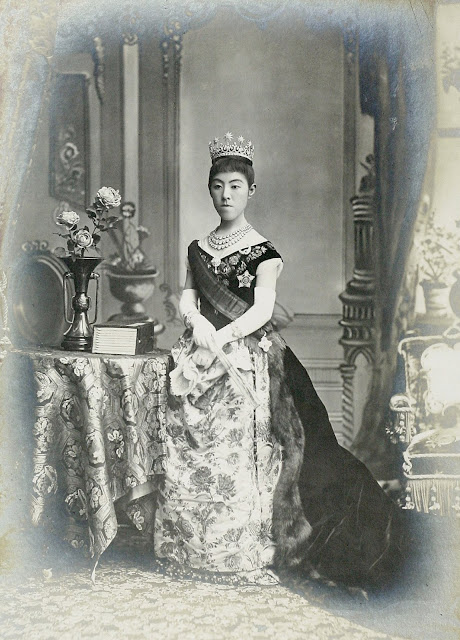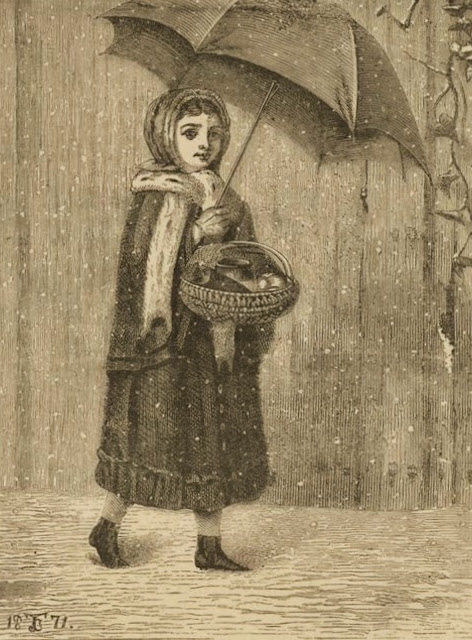 |
| What Have We Here? — A Shredded-Wheat dish made by George Jones & Sons in the 1930's. The dish features a blue and white scene of an Abby with a stonewall, large gateway and arched windows and garden landscape on a white background. It is approx. 7-1/4" long by 6-1/2" across by 1-1/2" deep. Marked on the bottom is “Shredded Wheat Dish Abbey, 1790, Geo. Jones & Sons, England” |
The Serving of Breakfast
Before the family assembles the water glasses are filled with fresh cold, or iced, water to within not more than an inch of the top. The finger bowls are half-filled with water of the temperature of the room. The butter is placed on the bread-and-butter plates; it should be the right consistency for spreading, not too hard nor too soft. The individual service of fruit is placed on the fruit plates, and if anyone drinks milk, a glass should be filled and put beside the water glass to the right.
After the fruit course is finished the fruit plate is removed, and at a formal breakfast the finger bowl is also removed, to be refilled with fresh water, and brought on again at the close of the meal. For the home and family breakfast there is no harm in allowing the finger bowl to remain on the table from its first use to its last.
 |
| A better look at a shredded wheat dish. The rectangular dish suits the rectangular breakfast cereal perfectly. |
The cereal is next brought on in a covered dish, and is helped by either the master or the mistress of the house. Cream and sugar are passed, or there may be individual cream pitchers, or one between two persons. This multiplication of individual dishes is, however, not to be recommended, for it makes much unnecessary work. Shredded wheat is not served from a large dish, being awkward to manage; it is served to each person in the individual cereal dish. This, and all the flaked and puffed grains, should be heated to crispness in the oven before being brought to the table, and served on slightly warmed dishes.
The individual cereal dish is a rather deep, saucer-shaped one, with a slightly flaring edge; or sometimes a small, shallow bowl is used. It is incorrect to serve the cereal on ordinary breakfast saucers; it is worse than incorrect, it is a decided mark of ignorance, to serve it in the small oval sauce or “side” dishes. These are no longer considered good form for any use - they belong to the days of the butter “chips” - but to serve the breakfast cereal in them has always been inexcusable.
The meat, fish, or other substantial dish is placed before the master of the house after the cereal course is removed, and is helped by him, with its accompanying vegetable (if there is one) on the individual breakfast plates. These may be passed by the waitress, or by those seated at the table. The simplest method is for the master of the house to place the first helping on the breakfast plate in front of him, which is then exchanged for that of the person first helped, and so on.
The warm rolls, biscuits, or muffins are piled on a round dish, or in a muffin dish. A folded napkin is laid under them at the bottom of the dish, and another laid over them, to keep them warm without having them ab- sorb their own steam and become soggy. This is hardly necessary when the family is small, but it is a dainty fashion. Dry toast is placed in a toast-rack; it is spoiled in a very short time if the slices are piled over one another; buttered toast, waffles, or pancakes are either piled in a covered dish or served fresh from the kitchen in individual portions.
Coffee is always poured by the mistress of the house, and when the family is small the cups and saucers, etc…, are arranged before her place when the table is set. Each cup should be in its own saucer, and the spoon should be placed in the saucer, parallel with the handle of the cup. This position of the spoon is one of the small points apt to be lost sight of.
When the substantial course and the hot breads have been placed on the table, the coffeepot is brought in and put on a tile or stand within convenient reach of the mistress. Where many have to be served, the whole coffee service is brought in on a tray, and placed before the hostess at the right time. Needless to say that cups and saucers should not under any circumstances be piled one over the other.
Cream and sugar should be put into the cups, for those who use these additions to their coffee, before the coffee is poured. This, to a sensitive palate, makes quite a little difference in the flavor of the coffee.— Mary Davoren Chambers, Boston Cooking School Magazine, 1920
🍽Etiquette Enthusiast, Maura J. Graber, is the Site Editor for the Etiquipedia© Etiquette Encyclopedia





















